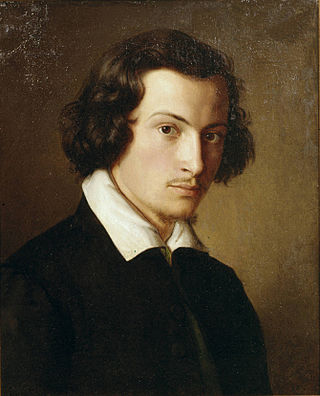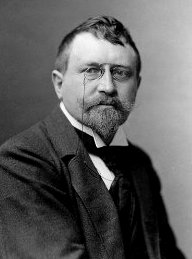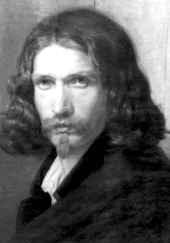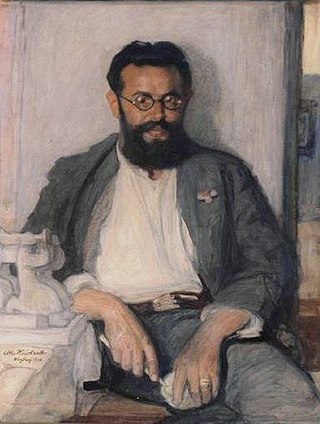This article needs additional citations for verification .(October 2016) |

Hugo Vogel (15 February 1855, Magdeburg - 26 September 1934, Berlin) was a German painter, known primarily for historical scenes and portraits.
This article needs additional citations for verification .(October 2016) |

Hugo Vogel (15 February 1855, Magdeburg - 26 September 1934, Berlin) was a German painter, known primarily for historical scenes and portraits.
His father was a merchant. After graduating from the Realschule in Magdeburg in 1874, he entered the Kunstakademie Düsseldorf, where he studied with Wilhelm Sohn and Eduard von Gebhardt among others. [1] He completed his courses there in 1880 and, three years later, exhibited several historical paintings at the Prussian Academy of Arts.

In 1886, following an extended visit to Italy, he settled in Berlin. The following year, he was given a professorship at the Academy, [1] a position he held until 1892, when he lost it as a result of the "Munch Affair". This involved an exhibit by the Norwegian artist Edvard Munch that was closed by the Academy's conservative Director, Anton von Werner. In protest, Vogel and several other painters joined together to create the "Vereinigung der XI ", a precursor to the Berlin Secession. Among his notable students during his tenure were August von Brandis and Clara Siewert.
In 1893, he went to Paris to study with Jules Lefebvre. After that, he travelled throughout Spain, North Africa, Italy and the Low Countries. In 1900, he was awarded a gold medal at the "Große Berliner Kunstausstellung", a prestigious art exhibition held from 1893 to 1969.
In addition to his canvases, he created frescoes with historical themes in several town halls; notably in Berlin, Hamburg and Merseburg. [1] In 1902, the fresco in Merseburg, Der deutsche Michael, became the subject of plagiarism accusations when the magazine, Der Kunstwart , pointed out its resemblance to an equestrian statue by Paul Dubois, depicting Joan of Arc.[ citation needed ]
From 1915 to 1917, during World War I, he accompanied Paul von Hindenburg to the Eastern Front as his official portrait painter. [1]

He is buried at Wannsee Cemetery. Streets in Magdeburg and Berlin have been named in his honor.

Edvard Munch was a Norwegian painter. His 1893 work, The Scream, has become one of Western art's most acclaimed images.

Philipp Veit was a German Romantic painter and one of the main exponents of the Nazarene movement. It is to Veit that the credit of having been the first to revive the nearly forgotten technique of fresco painting is due.

The Scream is a composition created by Norwegian artist Edvard Munch in 1893. The Norwegian name of the piece is Skrik (Scream), and the German title under which it was first exhibited is Der Schrei der Natur. The agonized face in the painting has become one of the most iconic images of art, seen as symbolizing the anxiety of the human condition. Munch's work, including The Scream, had a formative influence on the Expressionist movement.

Max Liebermann was a German painter and printmaker, and one of the leading proponents of Impressionism in Germany and continental Europe. In addition to his activity as an artist, he also assembled an important collection of French Impressionist works.

Julius Schnorr von Carolsfeld was a German painter, chiefly of Biblical subjects. As a young man he associated with the painters of the Nazarene movement who revived the florid Renaissance style in religious art. He is remembered for his extensive Picture Bible, and his designs for stained glass windows in cathedrals.

Anton Alexander von Werner was a German painter known for his history paintings of notable political and military events in the Kingdom of Prussia. One of the most famous painters of his time, he is regarded a main protagonist of the Wilhelmine period.
Conrad Hommel was a German painter. He was best known for his portraits of leading German entrepreneurs such as Max Grundig, Herbert Quandt, and politicians such as Adolf Hitler, Hermann Göring and Paul von Hindenburg.

Eduard Julius Friedrich Bendemann was a German-Jewish painter.

Franz Karl Eduard von Gebhardt was a Baltic German painter of portraits and historical scenes, and a professor at the Kunstakademie Düsseldorf.

Josef Block was a German painter.

The Berlin Secession was an art movement established in Germany on May 2, 1898. Formed in reaction to the Association of Berlin Artists, and the restrictions on contemporary art imposed by Kaiser Wilhelm II, 65 artists "seceded," demonstrating against the standards of academic or government-endorsed art. The movement is classified as a form of German Modernism, and came on the heels of several other secessions in Germany, including Jugendstil and the Munich Secession.

Johann Baptist von Lampi the Elder was an Austrian-Italian historical and portrait painter. He settled in the Russian Empire after the third and final partition of Poland, enticed by an extremely generous offer from the Tsar.

Gustav Graef was a German painter, primarily of portraits and historical subjects.

Benno Frederick Toermer (Törmer), was a painter. He was born and educated in Dresden, Saxony, in what is now Germany. He also studied and worked in Rome, Italy. Rome became his second home where he lived, with brief interruptions, until his death from a heart attack on 6 February 1859. While at the Academy in Dresden, Toermer painted religious and historical subjects, such as Joseph's interpreting dreams while in prison. When in Italy, his subjects were based on gods of legend and romantic motifs. Toermer often painted in the style of the old Dutch. In 1852 Toemer was invited to exhibit a work entitled “The Wedding Morning – Ill Omen” at the Royal Academy in London. He was an honorary member of the Patriotic Society of Natural History in Dresden. In July 1853 he was awarded the title of professor of Dresden by the Saxon Art Association.

Hugo Joseph Anton Freiherr von Habermann was a German painter and draftsman. He is sometimes referred to as "the Elder" to distinguish him from his nephew of the same name, who was also a painter.

Hugo Curt Herrmann was a German Impressionist and Neo-Impressionist painter; associated with the Berlin Secession.

Carl Sieg was a German portrait painter and lithographer.

Susanne Philippine von Nathusius was a German portrait painter who worked in Halle and Paris.

Große Berliner Kunstausstellung , abbreviated GroBeKa or GBK, was an annual art exhibition that existed from 1893 to 1969 with intermittent breaks. In 1917 and 1918, during World War I, it was not held in Berlin but in Düsseldorf. In 1919 and 1920, it operated under the name Kunstausstellung Berlin. From 1970 to 1995, the Freie Berliner Kunstausstellung was held annually in its place.

Otto Theodor Rudolf Heichert was a German painter and graphic artist; associated with the Düsseldorfer Malerschule.